- Podcast Listening
- Eclipse Images Supplement for 2017 Sept-Oct Mid-Mensan
- Notes on the August 2017 eclipse
- Remember When ....?
- What Winning the Lottery Doesn't Mean to Me
- CryptoGrams
- Palindromes
- Resolution
- A Few More Brain Teasers!
- Useful Mensa Links
- Even more Amazon Links to Share
Shop to Support the Mid-Hudson Mensa Scholarship Fund!
Mid-Hudson Mensa participates in Amazon's advertising referral program. Shopping through the links on this page earns advertising fees for our Scholarship Fund — at no additional cost to you! Note: American Mensa, Ltd., does not endorse these products or services. Amazon does not share with us who you are or what you bought.

Tip: You can share this page by passing along this easy-to-remember URL: http://tinyurl.com/MMMOORE. Remind people that they must commence shopping from this page for the Scholarship Fund to collect fees.
You can highlight and copy the URL from here:

Podcasts: Vice-President’s Column by Peter Carboni
I’m an avid podcast listener. When reciting a fascinating factoid to a fellow member, I often start by saying: “I heard this on a recent podcast …”. For me, this media is the prefect way for a busy Mensan to keep up with the world of ideas. Yet, I haven’t encountered any local member that shares the podcast “bug”. Last year’s “20 Questions” survey found a large fraction of the group was pressed for time, but maintained a wide variety of interests. If this is you, read on.
Mensa member Brian Kilby (Charlotte/Blue Ridge Mensa) was one of the earliest podcasters. It all started because Brian was a fan of the “Transformer” series of transfigurable toy robots. In 1999, he conceived the idea of recording a Transformers audio show for distribution on the Internet. He described the project as a “new, more rich, forum for Transfans”. The word “Podcast” hadn’t been coined yet, so he offered a description of this nascent technology that can be summarized as: an online radio show, in MP3 format, that would be downloaded from the Internet on a periodic basis. That’s still a good definition for what a podcast is. He reflected back then “if anyone would actually listen” to the show. Brian forged ahead, a podcast was born, and it is one of the oldest podcasts still produced today.
A few years after Brian’s initiative, Apple’s wildly popular iPod portable player was introduced. In the mid-2000s it was an important player (pardon my pun) in the exponential growth of podcasting. The demand for free audio content to fill these iPods (and like devices), development of software to automate downloading podcasts, and the buzz created by the newly invented word, “podcast” (a combination of “iPod” and “broadcast”) brought this media into the mainstream. Apple though, was not flattered by the use of “pod” affixed to software that was cropping up at the time. This forced some popular, pioneering titles to undergo a sudden name change to avoid legal problems. The word “podcast” stuck and even Apple embraced it.
Podcasts are now available for any topic you can think of and can last a few minutes to hours. Finding them is easy: use an Internet search engine (Google, Yahoo!, Bing, etc.) to enter a topic of interest, followed by the word “podcast” (try “history podcast” or “book club podcast”). Many radio shows archive episodes as podcasts (search on: “NPR Podcast”), allowing you to time-shift your listening. A query for “Mensa podcast” finds Mensa Education & Research Foundation’s “Conversations with Mensa” series. Many episodes are Colloquium topics.
Often, sites include the option of downloading the audio file or listening directly from the page. As an established medium, your software should be able to handle either way without any configuration.
If you stumble upon podcasts you’d like to listen to, as new episodes become available, search for “podcast aggregator” software to automate the downloading process. If you have Apple’s iTunes software, you’re all set: just type “podcast” in the search bar for a huge listing of podcasts – all free. Listen in iTunes by clicking the episode name or click the podcast series name to open a page with a “subscribe” button. Subscribing will download new episodes to your iTunes Library as they are made available.
If this short article has stirred your curiosity, I’ve created an online listing of the sites mentioned here: [below]. Happy podcast listening!
May 2012 Mid-Mensan, Vice-Presidents Column Podcast List
- iTunes download page
- iTunes Tips for Podcast fans
- Brian Kilby's 1999 description of podcasting
- Brian Kilby's Radio Free Cybertron (Transformer's podcast)
- Conversations with Mensa
- NPR Podcast List
- Historical Podcasts (A Collection of History Podcasts)
- Book Club Radio Program Podcast
2017 Great American Solar Eclipse on Monday, August 21, 2017
Supplement for 2017 Sept-Oct Mid-Mensan
—Peter Carboni
After driving 14-hrs Sunday, from the Hudson Valley of NY to a hotel outside of Knoxville, I awoke at 3 a.m. Monday morning for the final 90-min journey to my observing site. At 6 a.m. I arrived in Tellico Plains, Tennessee — population 941 — a farming community in the foothills of the Smoky Mountains that abutted the Cherokee National Forest. It was also near the center-line of the eclipse and the location expected about 2’ 37” of totality. I could make out heavy clouds in the pre-dawn sky that gave me some pause on what to expect that day.
A local church had promised a free pancake and sausage breakfast at 7 a.m. True to their word a small line had formed outside a food truck and I enjoyed my share of what they called "solar stack" pancakes. I was relieved to see the morning clouds burn off as the Sun rose for a mostly sunny day.
Right after 1 p.m. I began a series of timed exposures of the partial phases of the event when the Moon begins to cover the Sun. This series of images extended from before the start of the eclipse to a bit after sunspot 2671 was covered about 40-minutes later.
In the final partial phases, before totality, the light turned sunset-yellow and the breeze died. While the quality of the light had a familiar twilight-feel, it came from high in the sky and without any accompanying long-shadows. The other-worldly lighting added to the anticipation of the event. In the final seconds before totality, the sky dimmed rapidly and the crowd started screaming as we were engulfed in a deep twilight.
One of the alarms on my smartphone went off to remind me to remove the solar filter from the telescope. Totality is imaged without this filter. I did so and then clicked down and held the shutter button icon of the software on my laptop to take the first set of bracket images of totality. While the digital camera made its artificial shutter sound and the laptop screen told me that the images were downloading, I looked up at the spectacle the crowd was continuing to “oooh” and “ahhh” about.
My impression of the eclipse was a black hole in the sky surrounded by diaphanous material through which shown a blinding white light (the solar Corona) that turned the sky blue in its immediate vicinity. Away from the Corona all was nearly black and the Venus shown in the west.
With another alarm chiming on my smartphone, I put the solar filter back in place — the 2’ 37” of totality were over much too soon.
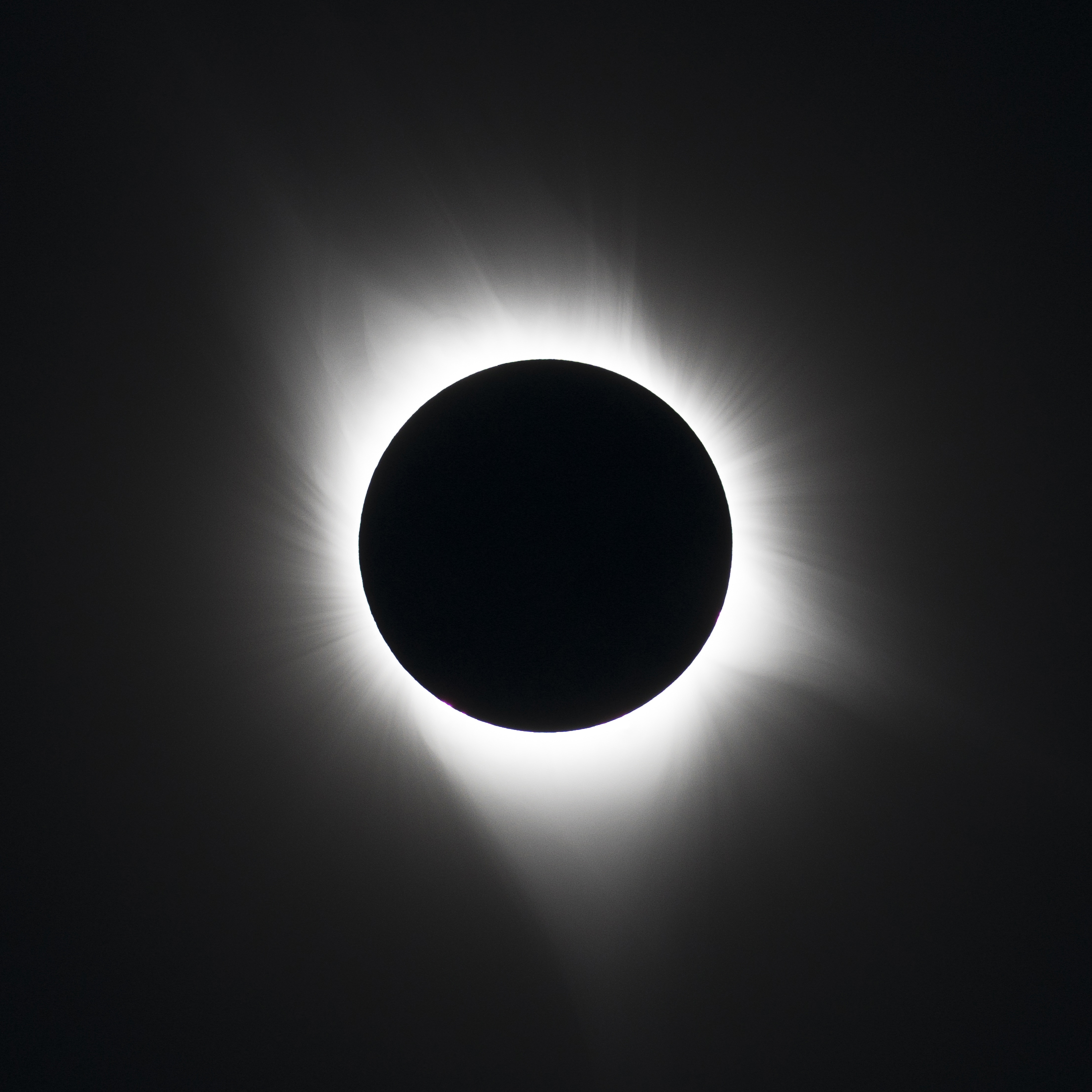
The glaring white Corona, the Sun's atmosphere, extends a great distance beyond the edge of the Moon. No single image captures totality as you really see it.
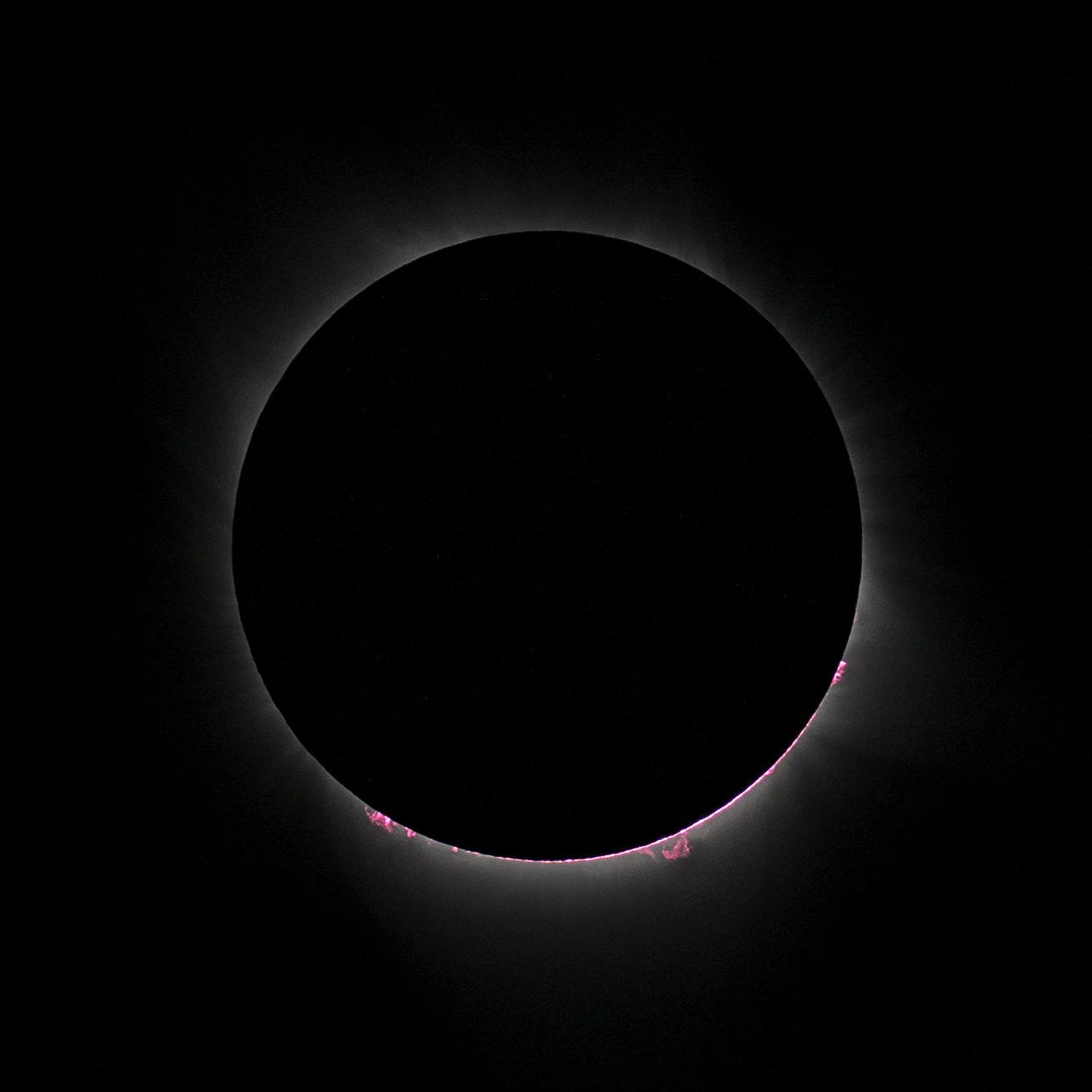
After 3rd contact the Sun began to emerge from behind the Moon. Red prominences are visible on the solar limb. Without the eclipse, you'd need an expensive Hydrogen-alpha scope to see this.
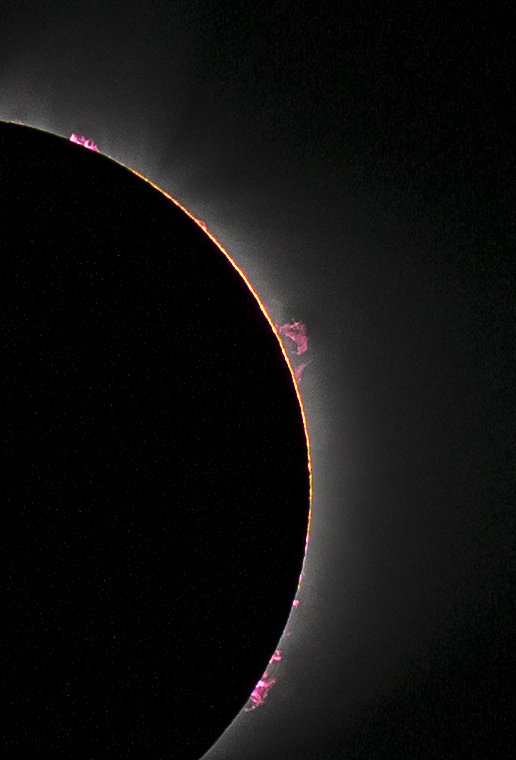
Same as above but cropped with the blue channel dropped on the solar limb to let yellow come through to create a striking image.

Same as above but 9-seconds later.
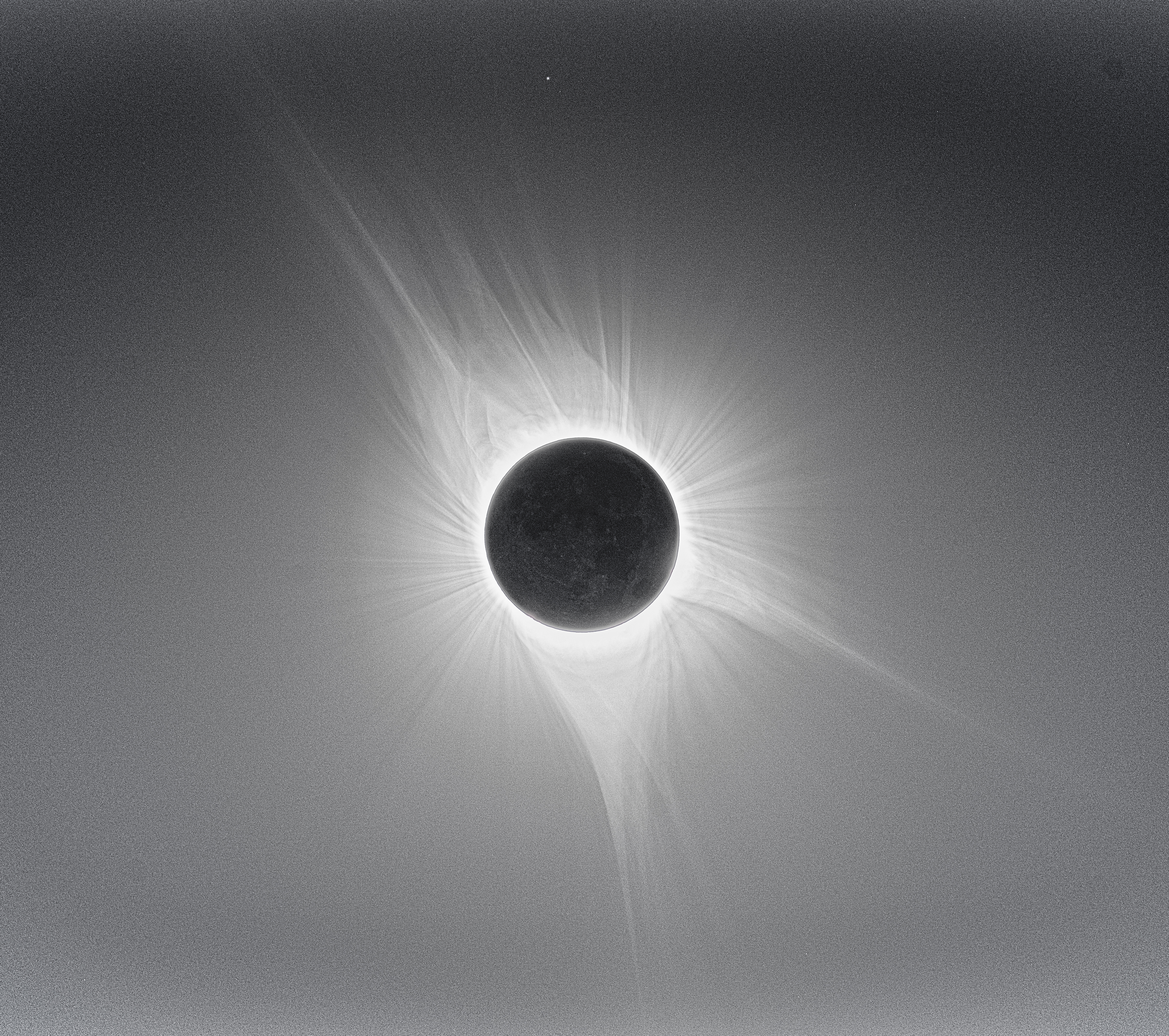
All my totality exposures combined and manipulated to show extent of the Corona. You can also see the face of the Moon from reflected earthshine.
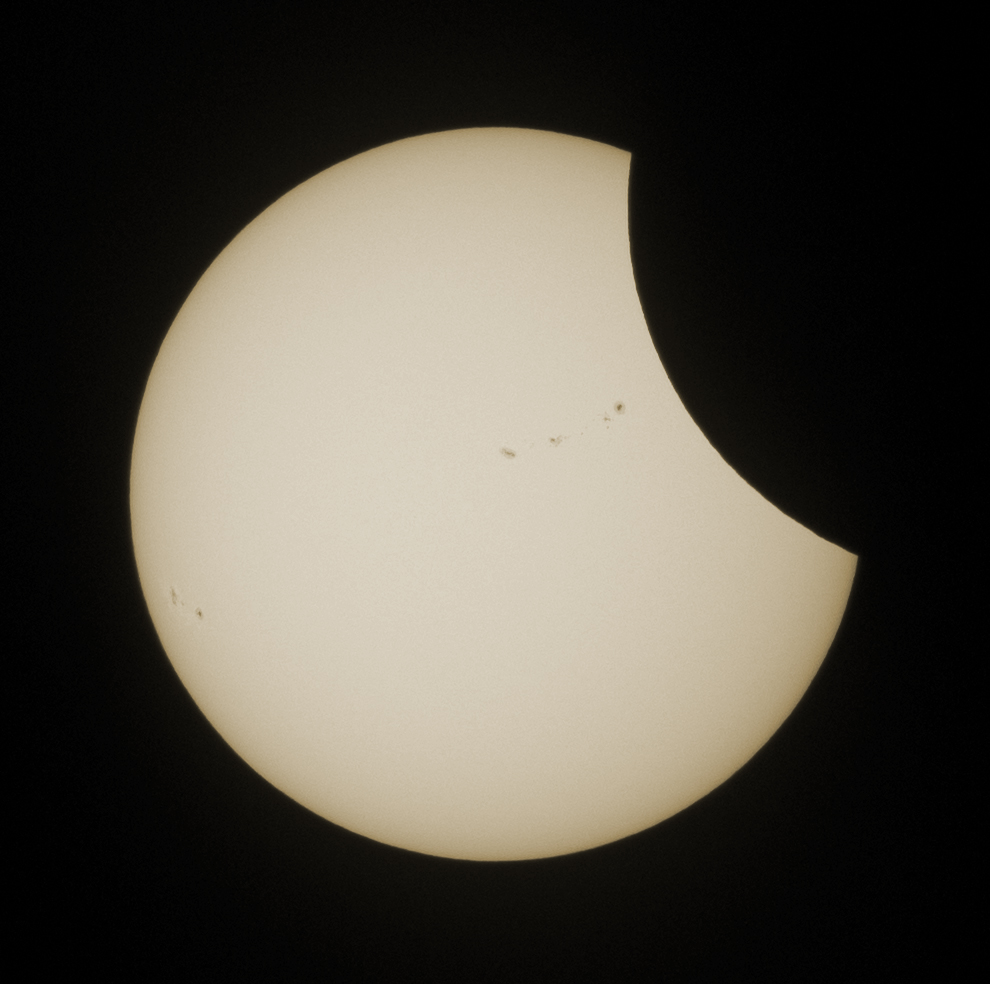
Moon approaching sunspot 2671 — this is the sunspot I focused my scope on prior to imaging.
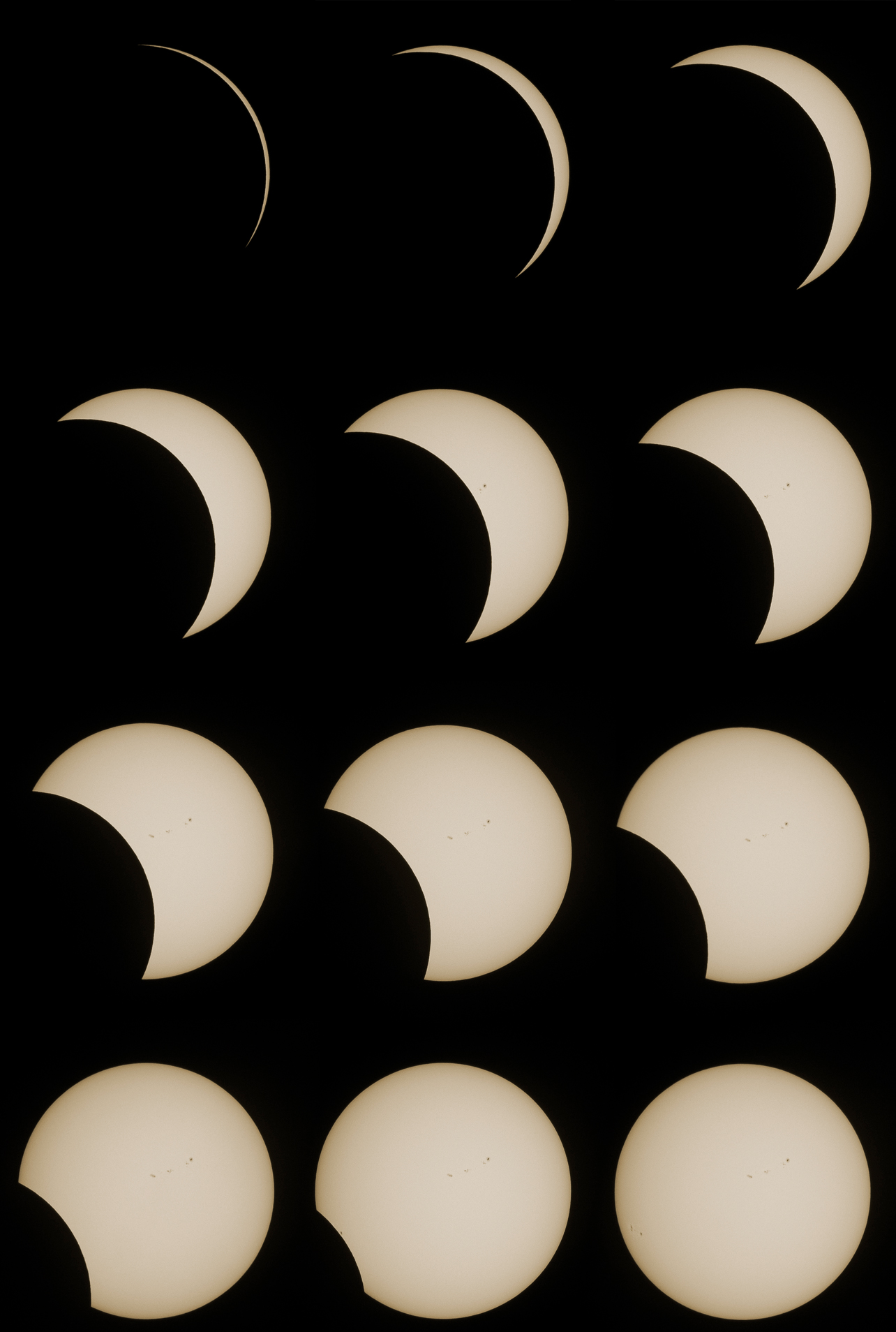
Every 8-minutes from the end of totality to the 4th contact — the end of the eclipse.
A short video I made for my company (most of the gear I took down I borrowed from them) featuring the images I took.

The 2017 Great American Solar Eclipse was the first eclipse visible in the contiguous United States since 1979! The circumstances are noteworthy for the following:
- The first with a path of totality crossing the USA's Pacific coast and Atlantic coast since 1918.
- The first where totality makes landfall exclusively within the United States since 1257 (over 500-years before there even was a USA).
Remember When ...? by LaVena Kay Kidd
History has a habit of getting lost. Do you remember when Friends debuted on TV? Our puzzle this month is all about dates. Your mission is to match the date with its historical or hysterical event.
1) VE Day 2) San Francisco Earthquake 3) Fall of the Berlin Wall 4) Battle of Gettysburg 5) Desi Arnaz's Birth 6) Princess Diana's Death 7) Premiere of Gone With The Wind 8) Charlie Brown's Christmas Debut 9) Kenneth Arnold reports sighting of UFO's 10) Cuban Missile Crisis 11) Battle of Trafalgar 12) Superman's debut in Action Comics #1 13) Defeat of the Spanish Armada 14) Battle of Waterloo 15) MTV goes on air 16) Edison patents the light bulb 17) Roger Maris breaks Ruth's home run record 18) Neil Armstrong steps on the Moon 19) Captain Kidd is executed 20) Kansas admitted to the Union 21) First Pizza Hut opens in Wichita
A) June 24, 1947 B) October 21, 1805 C) July 18, 1815 D) May 8, 1945 E) April 18, 1906 F) 1958 G) July 29, 1588 H) August 1, 1981 I) October 1, 1961 J) November 9, 1989 K) December, 1965 L) January 29, 1861 M) July 20, 1969 N) 1938 O) December 15, 1939 P) July, 1863 Q) May 23, 1701 R) 1880 S) October, 1962 T) August 31, 1997 U) January 19, 1953
What Winning the Lottery Doesn't Mean to Me by Mark Levy
I am driving home Wednesday night with a New York State lottery ticket in my pocket, thinking about how my life will change when I win $10 million. Most of us lottery players think about this topic, from time to time, especially in the moments before the winning numbers bounce into view from the wonderful, plastic bingo ball dispenser on TV.
We think about paying off our bills, buying jewelry (the outrageously expensive, gaudy kind), cars (ditto), and houses... many of them. We dream of taking trips -- always first class -- to exotic places. The more altruistic of us, of course, contemplate paying for our children's education or our parents' long term health care. For the especially generous among us, supporting one or more philanthropic causes is definitely on the list. This evening, however, I think not about what I would do with an appreciable portion of a multi-million dollar jackpot, but what I wouldn't.
From the grandiose to the trivial, I realize that my life is filled with things that can be eliminated by the possibility of independent wealth. Here are the things I intend to give up.
1. I would no longer peel or steam off uncancelled postage stamps.
2. When dining out, I would no longer agonize over the relative value of one appetizer over another on a
dollars per ounce basis.
3. I would no longer deduct the tax from my restaurant bill before I calculate the tip.
4. I would no longer begrudge the hat check woman her tip.
5. I would no longer park my car five blocks away from a restaurant or hotel to avoid valet parking.
6. I would no longer walk across the street merely to avoid the street musician with his open guitar case
obstructing the sidewalk.
7. I would no longer belong to any organization that required my presence at 8:00 o'clock or (shudder) earlier
in the morning... ANY morning.
8. I would no longer compare supermarket prices of tuna fish. Or cereal.
9. I would no longer purchase supermarket flowers.
10. I would no longer wait for my favorite brand of soda to go on sale, or settle for a generic brand.
11. I would no longer buy the economy size of anything that tends to get soggy, go flat, or smell yucky towards
the end of its life.
12. With respect to opened milk containers, I would no longer resolve doubt in favor of freshness.
13. I would no longer scrape the sides of peanut butter jars.
14. I would no longer precariously drain ketchup from one bottle to another.
15. I would no longer scoop melons down to the rind.
16. I would no longer drink tap water.
17. I would no longer eat leftovers. Come to think of it, I would no longer place leftovers in my refrigerator.
In fact, I would no longer have use for Saranwrap or Reynolds aluminum foil.
18. I would no longer put up with dull knives, dull scissors, or dull people at cocktail parties.
19. I would no longer borrow my neighbor's snow blower. In fact, I would no longer personally remove snow
from my driveway, or anyone else's. Or even my walkway.
20. I would no longer buy seats in the bleachers.
21. I would no longer be tempted to purchase a monstrously large popcorn and drink at the movies merely
because it's the best value.
22. I would never again see the inside of a store whose last four letters were "MART".
23. I would no longer buy my clothing out of season.
24. I would no longer wear jeans with holes in them (unless fashion designers made it clear that they looked the
coolest that way).
25. I would no longer check my watch before I began a long distance call and every minute thereafter. For that
matter, I would no longer even wear a watch.
26. I would no longer fill up with the lowest grade of gasoline. And I would never again pump gas myself.
27. I would no longer keep toll receipts.
28. I would no longer keep a list of books to watch for ___ a year after publication ___ when they are scheduled
to come out in paperback.
29. I would no longer reuse mouse traps.
30. Finally, I would no longer open any envelope on which Ed McMahon's face appeared.
CryptoGrams by Jim Jelacic
Easy:
TM HZR AFYO OZ DKK F DQZNOKN ATYOKN, GZNNZA XZYKH OQFO'D JRK TY OQK DLNTYP.
Hard - no punctuation, grouped in 5:
TZXJM JZMVJ IUPYR KUZXH NJKZW YHEPY ZKRYZ SVJIL JZHNJ UTQWT HLEUL VJ
 These pages and all content Copyright 2024 by Mid-Hudson Mensa,
all rights reserved. Mensa® and the Mensa logo (as depicted for example in U.S.
TM Reg. No. 1,405,381) are registered in the U.S. Patent and Trademark Office by
American Mensa, Ltd., and are registered in other countries by Mensa International Limited and/or
affiliated national Mensa organizations. Mensa does not hold any opinions, or
have, or express, any political or religious views.
These pages and all content Copyright 2024 by Mid-Hudson Mensa,
all rights reserved. Mensa® and the Mensa logo (as depicted for example in U.S.
TM Reg. No. 1,405,381) are registered in the U.S. Patent and Trademark Office by
American Mensa, Ltd., and are registered in other countries by Mensa International Limited and/or
affiliated national Mensa organizations. Mensa does not hold any opinions, or
have, or express, any political or religious views.